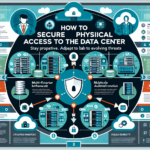Securing IT infrastructure for biometric authentication systems is critical to ensuring the confidentiality, integrity, and availability of sensitive biometric data and the systems that process it. As an IT manager responsible for datacenter, storage, backup, servers, virtualization, and other infrastructure areas, here are key steps to secure the environment:
1. Secure the Biometric Data
- Encryption: Encrypt biometric data both at rest and in transit using strong encryption standards (e.g., AES-256 for data at rest and TLS 1.2/1.3 for data in transit).
- Segmentation: Store biometric data separately from other datasets, ensuring that access is tightly controlled.
- Access Control: Implement strict access controls based on least privilege principles. Ensure only authorized systems, applications, and personnel can access the biometric database.
- Anonymization: Consider anonymizing biometric data to avoid linking it directly to individuals wherever possible.
2. Harden Servers and Storage Systems
- Patch Management: Regularly update and patch all servers, storage systems, and software to eliminate vulnerabilities.
- Firewall Protection: Use firewalls to restrict access to servers storing biometric data. Limit inbound and outbound traffic to only necessary services and protocols.
- Secure Storage: Implement robust storage solutions with built-in encryption capabilities and RAID configurations for redundancy.
- Auditing and Logging: Enable detailed logging on storage systems to monitor access to biometric data. Use a SIEM (Security Information and Event Management) solution for real-time alerting.
3. Implement Network Security
- Network Segmentation: Isolate the biometric authentication systems from other network segments to reduce attack vectors.
- VPN and Secure Connections: Use VPNs or private networks for remote access to biometric systems. Ensure all connections are encrypted.
- Intrusion Detection and Prevention Systems (IDS/IPS): Deploy IDS/IPS to detect and block malicious traffic targeting biometric systems.
4. Virtualization and Kubernetes Security
- Virtualization: Use hypervisor-level security features such as Secure Boot, VM encryption, and disk isolation.
- Kubernetes: Secure Kubernetes clusters by:
- Implementing Role-Based Access Control (RBAC).
- Using network policies to restrict pod communication.
- Ensuring proper secrets management (e.g., using tools like HashiCorp Vault).
- Regularly scanning container images for vulnerabilities.
- Isolation: Run biometric applications in isolated containers or VMs, limiting exposure to other workloads.
5. Secure Backup and Disaster Recovery
- Encrypted Backups: Ensure all backups of biometric data are encrypted and stored in a secure, isolated environment.
- Regular Testing: Test backup and recovery procedures frequently to ensure data integrity and availability during incidents.
- Air-Gapped Backups: Maintain offline or air-gapped backups to protect against ransomware or data breaches.
6. GPU and AI Infrastructure Security
- GPU Security: Secure GPU-enabled servers by regularly updating drivers, firmware, and monitoring for unusual activity.
- AI Models: If AI models are used for biometric recognition, ensure they are stored and deployed securely. Protect training data to prevent tampering.
- Inference Isolation: Ensure AI inference systems are isolated from other workloads and properly monitored for suspicious behavior.
7. Endpoint and Application Security
- Secure Biometric Devices: Protect endpoint biometric devices (e.g., fingerprint scanners, facial recognition cameras) by enforcing firmware updates, locking physical access, and monitoring device health.
- Application Code Review: Perform security code reviews for biometric applications to identify and fix vulnerabilities.
- Mobile Device Management (MDM): If biometric authentication is used on mobile devices, implement MDM solutions to enforce security policies.
8. Compliance and Legal Considerations
- Regulatory Compliance: Adhere to relevant regulations such as GDPR, CCPA, or others that govern biometric data.
- Privacy Policy: Clearly define and enforce policies for how biometric data is collected, stored, and used.
- Audit Trails: Maintain detailed audit trails to demonstrate compliance and assist in forensic investigations if needed.
9. Continuous Monitoring and Incident Response
- Threat Detection: Use advanced monitoring tools to detect anomalies in biometric systems and data access patterns.
- Incident Response Plan: Develop and test an incident response plan specifically tailored for biometric systems.
- Regular Penetration Testing: Conduct penetration tests and vulnerability assessments to identify weak points in the infrastructure.
10. Employee Training and Awareness
- Security Training: Train employees on secure handling of biometric data and the importance of protecting authentication systems.
- Phishing Awareness: Educate staff about phishing and social engineering attacks that may target biometric systems.
By implementing these measures, you can build a robust and secure IT infrastructure for biometric authentication systems while minimizing risk and ensuring compliance with data protection regulations.


